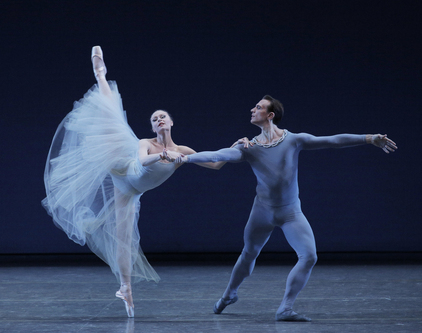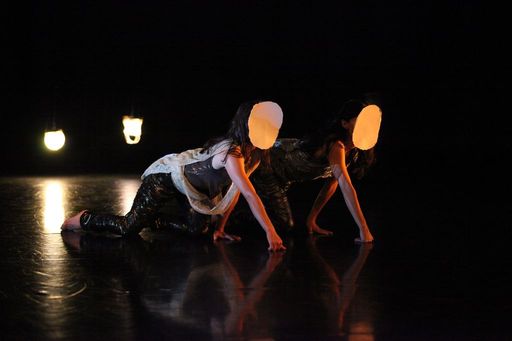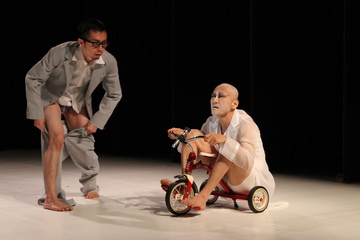Dance in January is dizzying and divided even by New York standards.
“Maybe it’s not right to talk about,” Balanchine said in his old age. “But . . . in everything that I did to Tchaikovsky’s music I sensed his help.” As a student at the Imperial Theatre School, Balanchine grew up inside Tchaikovsky ballets, and his first piece in America was to the composer’s Serenade for Strings. He identified his fellow St Petersburger not only with the courtly milieu of his childhood and a child’s exposed feelings but also with the kind of wondrous mystery that would allow a dead composer to commune with a living choreographer.
Divine agency in all its enigma and inexorability runs through and stretches over several of the Balanchine works in this season’s Tchaikovsky Celebration – the second of New York City Ballet’s three music-themed mini-festivals this year – and certainly in the first of the three programmes (alternating nights until January 27).
Serenade (1935) reflects the music’s huge shifts in scale and gravity by interweaving mass and individual – the impersonal corps’ seesawing, swirling, frothy patterns and the three principal women’s striking variations on them. These three elusive heroines seem to have emerged from the waves of destiny, to which they eventually succumb. The 30-minute ballet is so swift and protean and yet so sure of itself that you do not merely watch the principals; you want to know what drives them. The constant prick of mystery – “Why does this woman, and now this, evanesce into the wings?” – prepares us for the ultimate question, why one woman must die.
On opening night, the transfixing Janie Taylor imagined the sacrificial lamb as both wilful and desperate. All the principals danced with an unembarrassed pathos and emphatic gesture suited to the rich sound that guest conductor Roberto Minczuk conjured from the orchestra.
Janie Taylor and Sebastien Marcovici waltzing before her doom. Photo by Paul Kolnick for New York City Ballet.
In his fealty to the music’s spirit, Balanchine reordered movements. It is fine for Tchaikovsky to circle back to pomp after elegy, but the human element in dance discourages such a severe reversal of fortune. After death or misfortune, why would anyone be leaping around?
Which is the puzzle of the otherwise ravishing Tchaikovsky Piano Concerto No. 2 (aka Ballet Imperial). The queen abandons her beloved – Ashley Bouder limpidly demonstrating the stages of her disillusionment over the wooden Jonathan Stafford – only to make a grand appearance with him in the finale. I’d call that a non-sequitur, not a mystery.
In Mozartiana (1981)……
For the divine mystery in Mozartiana, click here. (First timers may hit a request to sign up. It is free and permits 10 Financial Times articles a month. Please click.)
Here are chunks from two Financial Times reviews I wrote last week, in the midst of the mania.
Inside the evening’s programme was a diagram of the constellation of handmade fish-skin lanterns hanging brightly overhead. The map’s key identified the person who constructed each delicate, irregular sheath and the exact number of miles this particular sacrificial salmon would have swum to return to its birthplace,spawn and die. The motif of displacement flitted through Niicugni (“Listen”). How far can a fish, a dance, a people or person – such as choreographer Emily Johnson, based in Minnesota, far from her native Alaska and her Yupik kin – stray and still remember the starting place? But Niicugni does not explore this theme so much as admit defeat before it – and in the process give us a shove.
The work can be rough at the seams, but you can count on this quirky annual showcase to present a more specific vision of contemporary Japan than BAM, the Joyce or Lincoln Center – all on the global circuit. Either deliberately or because they do not know any better, these young choreographers are refreshingly, if sometimes untranslatably, local.
Kentaro!!’s song-and-dance troupe Tokyo Electrorock Stairs is typically urban Japanese in its absorption and refashioning of American exports – in this case, gangsta hip-hop. In Send It, Mr. Monster four dancers executed cocky hand signals and low-slung, crisscrossing steps with that unlikely mix of bounce and emotional flatness that characterises Hello Kitty, big-eyed animé heroines and even Murakami novels. In a solo moment, rubber-limbed clown Kentaro!!’s air of exhaustion and insouciant fatalism added a subtle layer to the flat surface.
Mechanised businessmen and the old-man babies of butoh (“dance of darkness”) have appeared regularly in this showcase, but until now not in the same dance. Secret Honey Room began with choreographer Makoto Enda’s “a businessman gets dressed” solo: a whirlwind of suit, tie and unco-operative limbs. Soon Kumotaro Mukai’s white-faced imp rolled onstage on a tiny squeaky-wheeled tricycle to complicate matters, though not enough.
Photo for Japan Society by Julie Lemberger
These Japanese archetypes – upright harried citizen versus primordial folk spirit frozen in embryonic incompleteness in the wake of Hiroshima and western-style progress – needed common rhythmic ground to get entangled. Secret Honey Room only lurched and lulled between them.
For an unusual variation on the apocalyptic and how you can tell a troupe is not Japanese, click here.




journalist/critic = research/ factual accuracy
The Thank-you Bar = themes of displacement
Niicugni (Listen) = healing ceremony expressing gratitude and acknowledging all things as temporal parts of a whole via paying attention. (never had anything to do with displacement)
community group members (“schlubs”) = volunteer participants who share a common interest/activity: urban swimmers, mothers of young children, skateboarders, singer-songwriters, young dance students. particpated in no residency activities other than a single 1-hour rehearsal during tech week and dress rehearsal. These groups represent a cross section of each community the work tours to, connecting the work to the places it is performed.
And in terms of advice for a dance company, please do your homework before you embarrass yourself next time. perhaps read at least part of one interview with the choreographer to make sure you don’t completely miss-understand the intention of the work and put egg all over your face. watch a video about the role of the community groups at the MANCC.org website.
for example:
Posted 21 hours ago by Eva Yaa Asantewaa:
See if you can you snare a ticket to tonight’s concluding presentation of Niicugni–an interdisciplinary, movement-based work by Minneapolis-based Emily Johnson/Catalyst.
Presented at Baryshnikov Arts Center as part of PS 122’s COIL fest, the 70-minute work offers rich storytelling through poetic words, movement, soundscape and scenic design–all reflecting the values inherent to Johnson’s Central Alaskan Yup’ik heritage. It demonstrates and encourages empathy with all life–most memorably, those little red foxes imagined by Johnson and Aretha Aoki, on their nimble run through a forest and a batch of just-folks who periodically emerge from the audience to exalt in being part of the fabric of life.
If you manage to un-guard your heart and pay attention to subtle things–which is what the title, Niicugni, explicitly invites–you will perceive a gracefully-integrated, seductive work of art at the core of which is one rare, exquisite and charming performer, Emily Johnson. Oh, how I long to see more of her work!
Dear Mr. Mendez,
Well, I’m glad it made somebody happy!
And, yes, I did my homework: the interviews, the videos. Hours of it. But I’m not reviewing what “Niicugni” wanted to be, I’m reviewing the show before me. In the *show* the “volunteer participants” (your term) were dead space: schlubs. When I guessed, in parenthesis, that they might be participants in the residencies, this was a kindness on my part. Otherwise, there wasn’t even an extra-theatrical excuse for their presence.
Sincerely if wearily (oh, if only people could respond with neither insult nor self-righteous condescension: I’m so embarrassed on their behalf),
Apollinaire